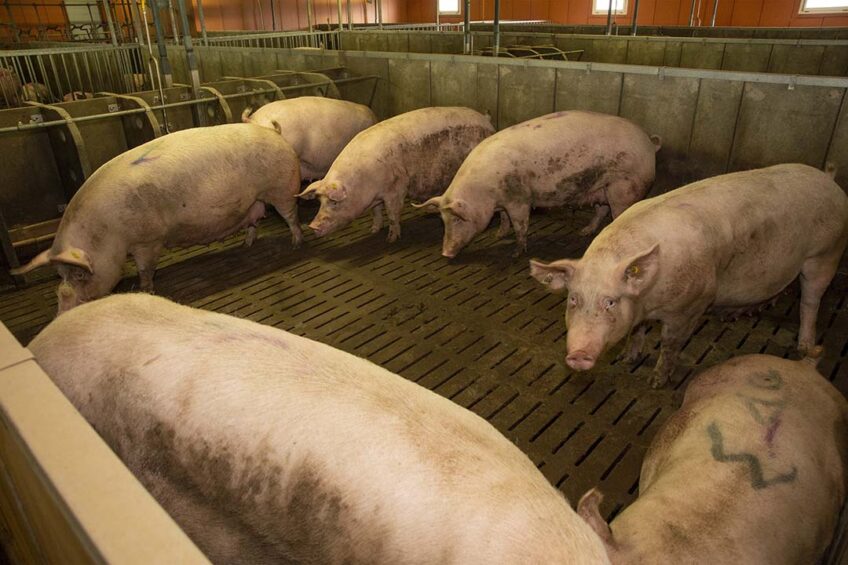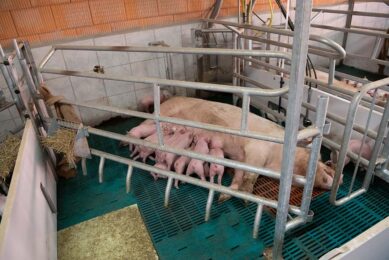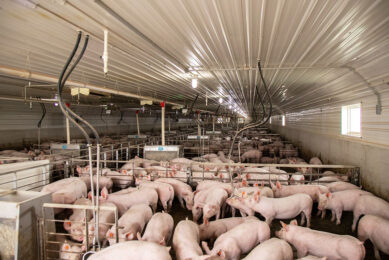Mixing early post-service lowers pregnancy and farrowing rates

Researchers from Italy and Ireland evaluated the effects of mixing time post-service on sow welfare and performance. They found a strong tendency for a lower pregnancy and farrowing rate of sows mixed 2 days post-service compared to sows mixed 28 days post-service.
Sows are kept in individual gestation stalls for the first month post-service. Pig farmers do this to protect them from stressors related to grouping and social competition during the embryo-implantation phase in the uterine wall. On the other hand, physical confinement in gestation stalls restricts movement and socialisation. This causes stress and frustration, and compromises sow welfare. Therefore, it is essential to determine the stage of reproduction at which mixing would be beneficial for sow welfare, while not being detrimental to reproductive performance.
Data collection
The researchers used 24 Large White x Landrace sows for their study. They moved sows to individual stalls in the service room 4 weeks post-farrowing. In addition, they artificially inseminated the sows at the onset of oestrus.
The team used 2 experimental treatments for this study:
12 sows were mixed into static groups 2 days post-service;
12 sows remained in individual stalls for 28 days post-service and were then mixed into static groups.
They measured back fat thickness to balance the treatments according to body condition. At approximately 110 days of gestation, the researchers moved the sows to the farrowing crates. A trained observer monitored aggressive behaviour immediately at mixing, and 24 hours, 8 days, and 3 weeks post-mixing.
The team counted fresh and old skin lesions 24 hours, 8 days, and 3 weeks post-mixing on the anterior (head, neck, shoulders, front legs), middle (flanks, back), and posterior (rump, hind legs), on the left and right sides of the body. They scored locomotion visually before mixing, 8 weeks post-mixing, and in late pregnancy using a Visual Analogue Scale ranging from 0 mm (not impaired) to 150 mm (severe impairment).
Reproductive performance measures including pregnancy rate (proportion of sows inseminated that resulted in pregnancy at 30 days after a real-time ultrasound examination), farrowing rate (proportion of sows inseminated that farrowed) and litter size (number of piglets total born, born alive, stillborn, and mummified) were also recorded.
Impact of mixing time post-service
The number of fights recorded on the day of mixing was numerically higher in sows mixed 2 days post-service compared to sows mixed 28 days post-service. In addition, for both experimental treatments the number of fights sharply decreased 24 hours after mixing, while the number of aggressive behaviors decreased in both treatments 8 days later. By 21 days post-mixing, no fights were observed, and the number of aggressive behaviors was low in both treatments.
The intensity and/or the duration of the aggressive encounters were similar between the 2 treatments, despite the difference in the frequency of occurrence of aggressive encounters. In addition, fresh lesion counts sharply decreased between 24 hours and 8 days post mixing in both treatments. The high number of lesions recorded at 8 days post-mixing in sows in both treatments suggests that the presence of free access stalls could have prolonged establishment of the social hierarchy as sows were able to ‘hide’ in them and thereby to avoid encounters with unfamiliar sows in the loose area.
Low locomotion scores
Furthermore, 6 of the 12 sows that were mixed 2 days post-service and were not pregnant when scanned at 30 days post-service had a higher number of fresh skin lesions at day 8 post-mixing compared to the average. Meanwhile, the 3 sows mixed 28 days post-service that lost their pregnancy after the ultrasound examination at day 30 had a lower number of skin lesions at day 8 post-mixing compared to the average number. Locomotion scores were low throughout pregnancy with a very low occurrence of lameness. There was no effect of treatment and time on locomotory ability at any point throughout pregnancy.
Conclusion
The authors found a strong tendency for numerically lower pregnancy and farrowing rate of sows mixed 2 days post-service compared to sows mixed 28 days post-service.











